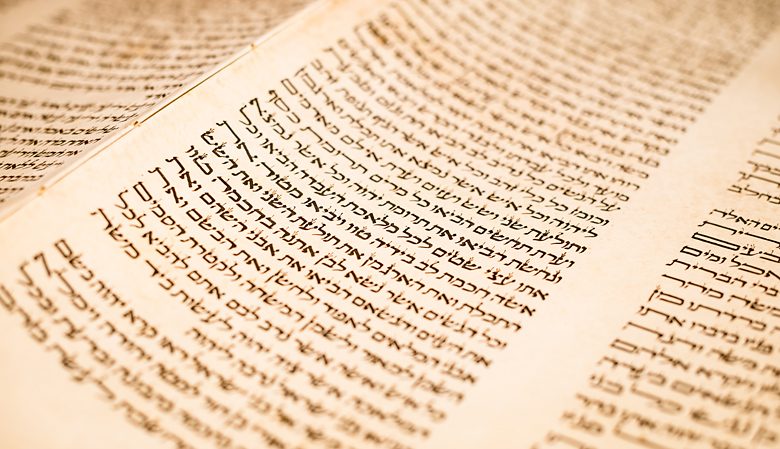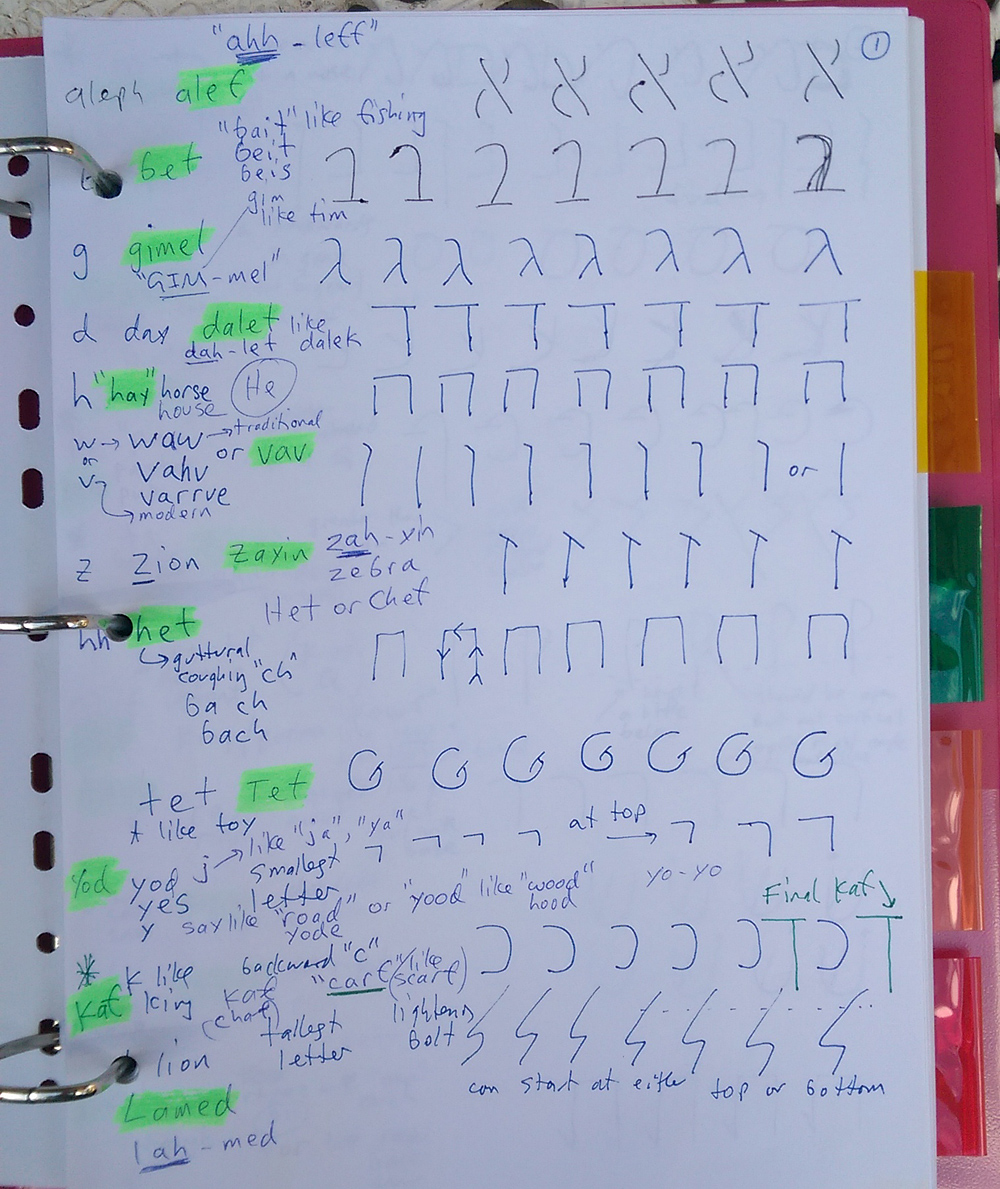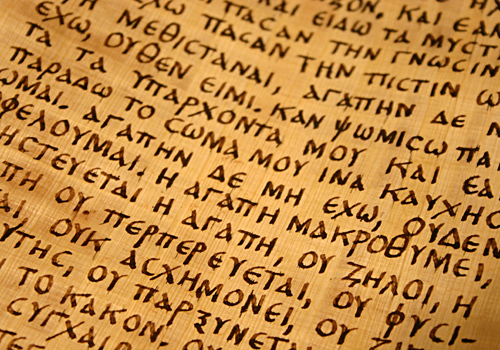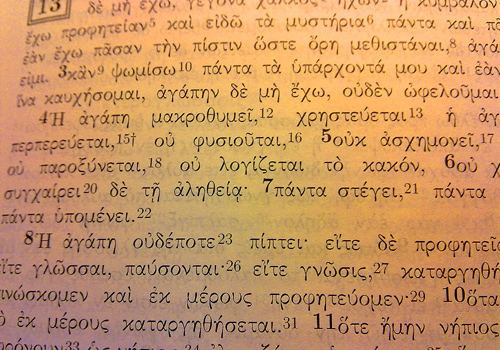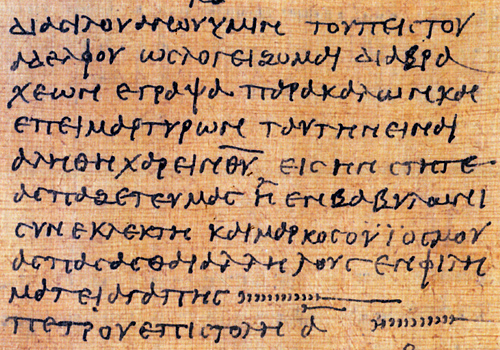How I Began Learning the Biblical Languages
This page describes how I started learning the biblical languages of Biblical Hebrew and Koine Greek. This year (2019) I'm going to be formally studying them at Morling College in Sydney, Australia — however I've spent about a year on and off teaching myself the basics of them at home to give myself a head start.
See also: Shortcuts for Beginning Biblical Hebrew, Shortcuts for Beginning Koine Greek.
I'll add a few more pages eventually, that give an overall introduction to the biblical languages. I'm not expecting that this will turn into anything like a full language course — it's more like a quick way to initially get into the languages, and a guide to how you can proceed further, if you're interested in learning more. There are many excellent courses available, yet most Christians are very unfamilar with and daunted by the idea of learning the original languages of the Bible.
This section of the website is meant to function like one of those "quick start guides" like you often get when you buy a new product — which you look at first, and is intended to make it (relatively) easy to get started with your brand new product. By contrast, the formal biblical language courses are like the full instruction manual to the product.
I was inspired to start learning Biblical Hebrew and Greek when I picked up a "Reader's" Hebrew Bible one day in my local Christian bookshop (Koorong), in November 2017. After several minutes of looking through the books on the languages shelf, I fell instantly in love with them. And realised as of that moment that I would have to learn both Hebrew and Greek. This was in fact my initial inspiration to study at Bible College, which you can read more about here.
I'm still only a beginner at the biblical languages, so the way I'm explaining here what I've learned so far may not be 100% textbook-perfect. But it's working for me so far. I've tried to simplify things as much as possible, to learn just the essentials — and then I can go back over it all later (such as in my formal courses) and fill in any missing technical details.
I'm only learning myself still, and I've yet to discover this personally: But I've heard people who know the original languages say that reading the Bible in them, compared to English translations, is like watching colour TV versus black-and-white TV. And that there are a lot of extra meanings and fine details which become lost in the English translation of God's Word.
If you want to move on immediately to a language quiz — that most English speakers, with zero knowledge of any other language will be able to have a decent try at — try the Greek Word Quiz (with the transliteration turned on). Unlike Hebrew, many of the Greek letters look very much like (and a few are identical to) English letters. Which means you can attempt this quiz with no prior knowledge of Greek.
Hebrew Versus Greek
The Old Testament was originally written in Hebrew (with a very few parts originally written in Aramaic). The New Testament was written in Koine Greek. Koine means "common", as opposed to the more formal Classical Greek. There are different ways to pronounce many of the words, but most people seem to say Koine as "COIN-ay" where "coin" sounds like money, and "ay" rhymes with bay or hay or say.
I started with Hebrew first. It was the first one that I discovered in the bookshop. The "Reader's" version of the Bible has definitions for the less common words as footnotes on each page — which means you only need to know a few hundred words to be able to read it. That helped a lot to make me initially think, "I could actually learn this". The Reader's Greek New Testament is similar (except you need to know even less words).
From what I've heard, most people find Hebrew harder than Greek. The Hebrew alphabet is a lot more different to English than the Greek alphabet. And the vowel system (and in fact the whole language) seems quite "hieroglyphic" at first. This was definitely part of the appeal for me, as it seemed extra special and magical/supernatural, like something out of a childhood Indiana Jones fantasy. The good thing about Hebrew is that I found that it's surprisingly easy to get the hang of the alphabet and vowels, and basic pronunciation of words, once you put a bit of effort and time in. In fact it was a lot easier than I expected at first. Also the language is a lot more consistent than English (and I think probably more than Greek too) in that once you learn the basics, you can read out loud from a Hebrew Bible, and more or less get nearly all the words correct. Except that at first, you won't have any idea what most of the words mean.
So far, it looks like (and I've been told that) the more difficult part of Hebrew is going to be that there's a lot more words to learn than Greek — and the words are much less familiar to English speakers than the Greek words. Many Greek words are familiar in English. e.g. "októ" means "eight" (think of octopus), "pyr" or "pyra" means "fire" (think of funeral pyre, or pyromaniac), "phobos" means "fear" (think of phobia), etc. A lot of Greek words are like this, but very few Hebrew words. You can see more of these already-familiar Greek words here (in a Google search).
I already knew most of the Greek alphabet from maths and physics, so I can't comment in an unbiased way about how much easier or harder it was to learn than the Hebrew alphabet. But it's definitely much more like English than the Hebrew letters.
Learning the Biblical Hebrew Alphabet
The first biblical language I looked at was Hebrew. The first thing to know about Hebrew is that it's written from right to left on the page, in the "backwards" order to English. This applies both to the letters within each word, and to the words themselves on the page.
I started with this video (below) on YouTube, before I bought anything. A day or two after watching it, I went back to Koorong — and bought the Reader's Hebrew and Greek Bibles, and a box set of learning materials for Biblical Hebrew. Shortly after that (and only after because it wasn't in stock, and I had to order it), I bought a box set of learning materials for Biblical Greek. I also bought several other language books and resources over 2018, which I'll describe on this website in due course...
Initially I watched this video in three separate sessions, with the Hebrew alphabet split into two sessions, and then a third for the part at the end that covers final forms and a few other things. I didn't have any of the learning materials at this stage so I just used blank A4 printer paper to write the letters on. I've included photos of the first pages I wrote while I watched this video after the video below.
This video is the first of a DVD series, but only this first video (which teaches the Hebrew alphabet) is freely available on YouTube.
Here's my written notes I made during the first time I watched the alphabet section of the video. I added the "final form" letters in green writing (not the green highlighting) later on. Page one:
And page two:
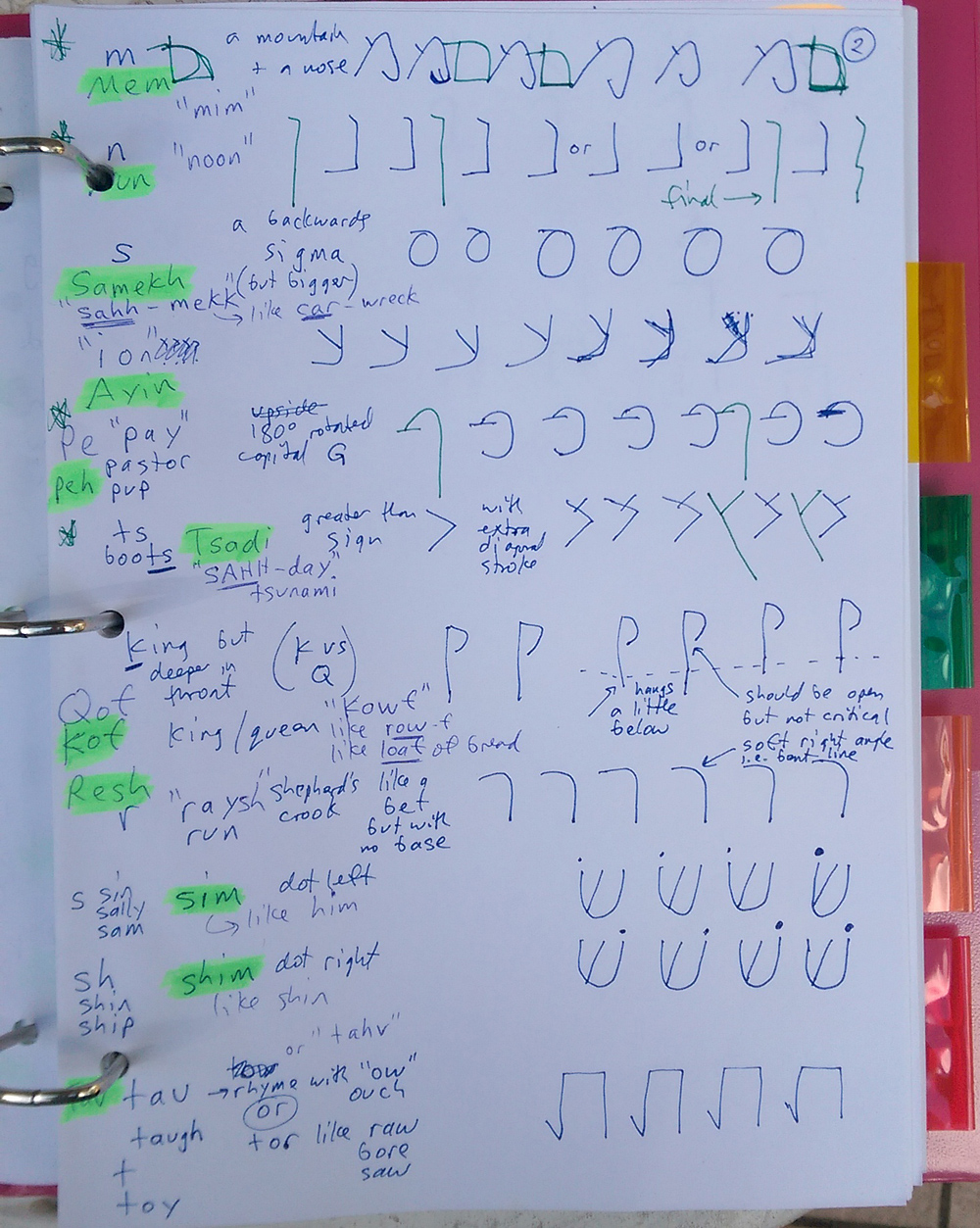
The first time I wrote the second half of the Hebrew alphabet. The green "final form" letters were added later on.
After that, the next thing I did was to find a Hebrew alphabet song on YouTube to help me remember the letters. There are many different versions of Hebrew alphabet songs. For some reason I found it easiest remembering the first part of the Hebrew alphabet from the video directly below, and the second part of the Hebrew alphabet from the song I've included after this one.
With the next video, I found the end easiest to remember. Note that this song includes extra variations of a couple of the letters, which I didn't learn at first. Specifically, Bet/Vet; Kaf /Chaf; and Pe/Fe are counted separately in this video but I only learned the first version of these originally. Note that in the video below, each two of these three pairs of letters look identical except for a dot in the middle of the first one. The dot is called a Daghesh Lene — it can appear in six of the letters (Bet, Gimel, Dalet, Kaf, Pe, and Tav), and makes the sound "hard" rather than "soft". But I would recommend just learning the basic letters first (without the dot), and then after you know them, you can learn about the Daghesh Lene. This is explained from 49:27 in the embedded video at the top of this page.
So I ended up breaking up the Hebrew alphabet like this in my head (written in English order from left to right):
Aleph א, Bet ב, Gimel ג, Dalet ד,
He ה, Waw ו, Zayin ז.
Het ח, Tet ט, Yod י, Kaf כ,
Lamed ל, Mem מ, Nun נ.
Samech ס, Ayin ע, Pe פ,
Tsade צ, Kof ק, Resh ר.
Sim שׂ... Shim שׁ... Tav ת.
Final Forms
The next thing to learn are the "final forms" which refers to five of the letters having a different shape when written at the end of a word. This is taught beginning from 41:04 of the first video on this page. It helps a lot to learn that 4 out of 5 of the final form letters (all except for Mem) look similar to their non-final forms, but with the bottom part of the letter straightened out and made into a long tail. You can see this in my hand-drawn pictures above (written in green lettering).
Begadkephat Letters
Then learn the six letters which can contain the Daghesh Lene (i.e. a dot in the middle of the letter), as described very briefly above, and which begins from 49:27 in the first video on this page. These six letters are known as the "begadkephat letters". This name is based on what they sound like if you try to pronounce the sound of each letter (it's actual sound, not it's name) with all six of them run together as a single word — as in "BGDKPhT", written in Eng lish letters in English left-to-right direction, or בגדכפת, written in Hebrew letters in Hebrew right-to-left direction.
Hebrew Vowels
You may have noticed that the Hebrew letters above are all consonants. (Except for Aleph and Ayin, which are silent letters in this system of learning Hebrew, and are used like place holders, around which vowel symbols can go.) The vowels were originally not written down at all — you just had to know what the words were meant to sound like. Then much later, a system was developed to allow the vowels to be written as extra symbols around the existing consonants, and which allowed the words to be written with vowels without altering the spelling of the original biblical text (i.e. of the consonants).
The vowels are written as symbols (like lines or dots), usually below the consonants, and sometimes above and to the left.
These will be covered on another page I'll add soon...
Practicing the Hebrew Alphabet
Once you know the Hebrew alphabet to the level of this web page, even without the vowels, you can have a go at the Hebrew Word Quiz (provided that the transliteration is turned on), and you should be able to make some sense of it. Though it will be much easier once you learn the Hebrew vowels. Knowing the final forms of the five letters which have them will also help a lot. Remember that the Hebrew letters in each Hebrew word are read "backwards" from right to left.
See also: Greek Word Quiz, Hebrew Word Quiz.
See also (free external links): Free Greek course online at Morling College in Sydney. The Master's Seminary Biblical Hebrew Full Video Course. Course Textbook and other PDFs (free). Other courses here.


